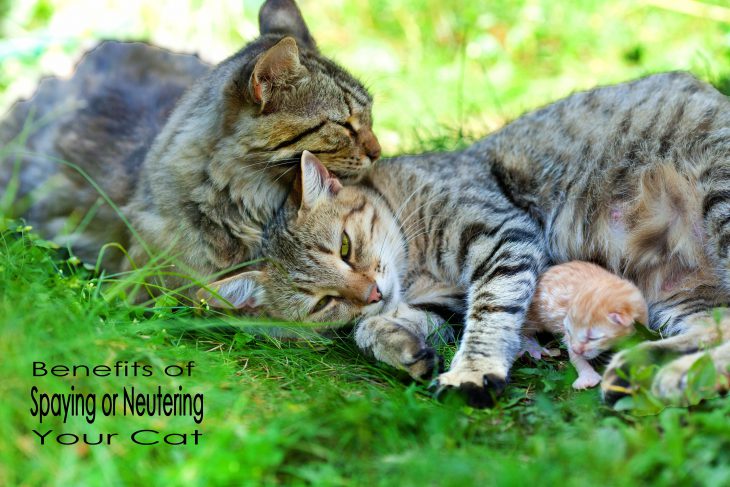Cats love to reproduce. While cats are not as prolific as rabbits, they certainly do not lag behind in the procreation arena. According to the American Society for the Prevention of Cruelty to Animals (ASPCA), “the average number of litters a fertile cat produces is one to two a year; the average number of kittens is four to six per litter.*” That’s a lot of cats.
To make matters worse, approximately 1.3 million cats are euthanized* at animal shelters each year. These cats are mostly strays who weren’t able to be returned to their owners, or were not adopted.
The spaying or neutering of cats has proven to be the most effective way to control the cat population However, besides population control, spaying or neutering cats provides some health and behavioral benefits.
What’s the difference between spaying and neutering a cat? It’s all about gender. In veterinary medicine, the term neuter is used when referring to the surgical removal of a male cat’s testes. The term spay is used when referring to the surgical removal of a female cat’s ovaries and uterus.
FAQ’s About Spaying a Female Cat
Why spay a female cat? Spaying a female cat is a good way to reduce the chances of mammary cancer, heat cycles, urine marking, and avoid unwanted kittens.
At what age should I have my cat spayed? Six months of age is the typical age for spaying. In recent years, more veterinarians and animal shelters are recommending that a female cat be spayed as young as eight weeks. Others recommend that a kitten be brought in for the procedure when it reaches 3.5 to 4 pounds in weight. Why? Cats tend to heal better when they are younger.
What is removed during the surgery? An incision is made to remove the ovaries and the uterus. The cervix is tied off. The ovaries need to be removed intact because they create heat cycles, behavior problems, and might cause mammary tumors to develop.
How long is the recovery period for a female cat that has been spayed? Most pet hospitals require an overnight stay. Expect your cat to not eat for a day, but by the second day your cat should be back to normal. There may be some swelling around the incision area. There should no fluid drainage or bleeding at the incision. The swelling should go away in 3-4 weeks.
FAQ’s About Neutering a Male Cat
Why neuter a male cat? Neutering can help a male cat adjust to domestic life. Roaming, fighting and urine marking are natural traits of a healthy male cat. While these traits are important in the wild, they can be very objectionable in the home. Male cats who have been neutered tend to get along better with other pets. They also lose their tendency to wander off or mark their territory by urinating everywhere.
At what age should a male cat be neutered? Typically, male cats can be neutered at six months of age. In recent years, animal shelters and veterinarians have been recommending that male cats be neutered when they weigh three to four pounds.
How long is the recovery time? Kittens are discharged on the same day as surgery. It is recommended that the cat should not be bathed for 14 days after surgery to ensure the incisions have healed properly.
What happens during surgery? Your veterinarian or animal shelter will ask you to bring your cat after it has fasted overnight. Your cat will be anesthetized just before the surgery begins. During surgery, a small incision is made on the scrotum to able to bring out the testicles. The cords that are connected to the testicles are pulled free and tied to each other and the testicles are cut free. In some cases, the cords are tied by using a small suture. The incision made on the scrotum is quite small. Therefore, it does not require stitches in most cases.
To sum it up, spaying or neutering a cat is effective in helping control the cat population. In addition, spaying and neutering provides health and behavioral issues. Spayed female cats are less prone to heat cycles, urine marking and are less likely to develop mammary tumors. Neutered male cat tend to be less aggressive, don’t tend to wander, and will not urine mark a home. If you have recently adopted a cat or a kitten, it would be in the best interest of your pet to have it neutered or spayed.
*Source: Pet Statistics. (2016) https://www.aspca.org/animal-homelessness/shelter-intake-and-surrender/pet-statistics Accessed on August 1, 2016.





